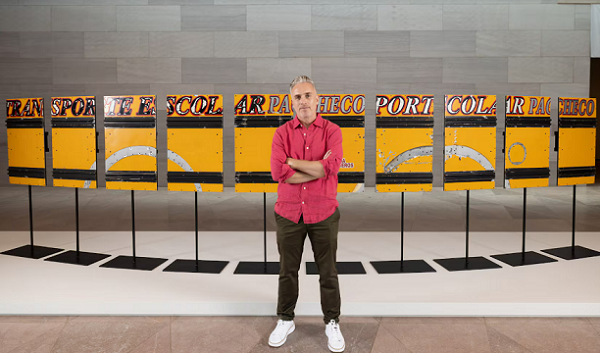
The full title of this outstanding article by José A. Delgado (El Nuevo Día) is “Art honoring social protest: Two works by Miguel Luciano are on display at the National Gallery in Washington, D.C.” Delgado reviews work by Puerto Rican artist Miguel Luciano, whose social commentary pieces “Escudos” [Shields, shown above] and “Cooño” [shown below] are part of the permanent collection of the National Gallery of Art in Washington, DC. Here are translated excerpts from El Nuevo Día.
Puerto Rican artist Miguel Luciano presents works at the National Gallery of Art in the US capital that portray the two most important and massive protest movements in Puerto Rico over the last quarter-century: the struggle that achieved an end to the US Navy bombings in Vieques and the demonstrations that culminated in the resignation of then-Governor Ricardo Rosselló.
Created in 2020, the sculpture “Shields” honors the hundreds of thousands of Puerto Ricans who, for approximately two weeks in the summer of 2019, took to the streets to demand the removal of a governor who offended large sectors of the Puerto Rican population in a chat with several of his top advisors and also denounced acts of corruption in the Department of Education.
Meanwhile, the painting “Cooño” (2000), is a response to the protests against the Navy after a bomb killed security guard David Sanés in April 1999 at the site of the former military firing range in Vieques, using a highly charged and biased advertisement from nearly a century ago as a model. Both artworks have been part of the permanent collection of the National Gallery of Art since 2023 and are on display in the institution’s east side.
“They are the two biggest social protests in Puerto Rico in my lifetime,” Luciano shared in an interview with El Nuevo Día, just as the “Shields” exhibition opened to the public.
In 2023, “Escudos” was part of the acclaimed exhibition of Puerto Rican artists, “No Existen un Mundo Post-Huracán: Puerto Rican Art in the Wake of Hurricane María,” at the Whitney Museum of American Art.
Luciano, who lives in the old Puerto Rican neighborhood called “El Barrio” [Spanish Harlem] in Manhattan, was working on a project about the Young Lords when he was struck by the intensity of the protests against Rosselló.
“We were seeing protesters taking to the streets, demanding change for the island. Those connections between Puerto Ricans in Puerto Rico and the diaspora formed a powerful parallel. I decided to honor the protesters, but also to address the issue of school closures, which for me was one of the most devastating impacts of the debt crisis, the imposition of the Promesa law, and the entire colonial situation,” he noted.
“Shields”—apparently the first sculpture by a Puerto Rican artist to be part of the National Gallery of Art’s permanent collection—was made from the body of a school bus confiscated from the Pacheco School Transport company in Corozal. [. . .]

The History of Protest
For Luciano, the acquisition of his works “Escudos” and “Cooño” by the National Gallery of Art follows previous acquisitions by the Museum of American Art (“Pure Plaintainum” and “Double Phantom”) and the National Portrait Gallery (“Porto Rican Cotton Picker” and “Freedom Rider Vest”).
“Cooño” has been placed in the Pop Art exhibition, in the same wing as Faith Ringgold’s famous 1960s painting “The Flag is Bleeding,” an expression of protest at a time when the civil rights movement and protests against the Vietnam War were intensifying. [. . .]

Excerpts translated by Ivette Romero. To read full article by José A. Delgado (in Spanish), visit https://www.elnuevodia.com/corresponsalias/washington-dc/notas/el-arte-de-miguel-luciano-sobre-la-protesta-social-en-puerto-rico-se-exhibe-en-la-galeria-nacional-de-arte-de-washington-dc/n
